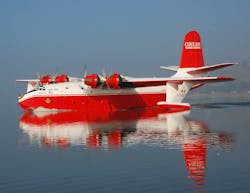Researchers ask industry to design long-range, heavy-lift seaplane able to operate for weeks in rough seas
ARLINGTON, Va. – U.S. military researchers are ready to ask industry to design and build a futuristic seaplane able to operate in rough seas for weeks at a time, and carry payloads as heavy as 45 tons for distances between 4,000 and 6,500 miles.
Officials of the U.S. Defense Advanced Research Projects Agency (DARPA) in Arlington, Va., have issued a presolicitation (HR001122S0027) for the Liberty Lift program, which focuses on developing a heavy-lift, long-range seaplane that operates efficiently in ground effect.
Liberty Lift focuses on a seaplane with extended maritime operations in high sea states that is affordable to produce, and that involves complex flight and sea surface controls.
The Liberty Lift long-range seaplane must provide smooth operations in ground effect in waves that are four to eight feet high. Ground effect describes the added aerodynamic buoyancy produced by a cushion of air below an aircraft moving closely to the ground or surface of the water.
Related: Sikorsky to build nine CH-53K heavy-lift helicopters
Flight should be smooth while flying over waves as high as eight to 13 feet, with high lift at low speeds to reduce wave impact loads during takeoff and landing in waves from 4 to 8 feet high. The seaplane should accommodate wave impact loads and be able to operate in high-traffic areas. The aircraft should be able to operate at sea for weeks at a time with long periods between land-based maintenance.
DARPA researchers are emphasizing low cost, easy-to-fabricate designs, with Liberty Ship-style manufacturing. The seaplane also should have complex aero and hydrodynamic interactions during takeoff and landing, with advanced sensors and controls to avoid rogue wave impacts.
The Liberty Lift seaplane should be able to take off and land in waves from four to eight feet high; fly in ground effect above waves from 8 to 13 feet high; fly at altitudes from ground effect to 10,000 feet, and operate for four to six weeks at a time carrying payloads of at least 90 tons.
On-water amphibious payload deployment and retrieval should be via nose and tail ramps; the seaplane should be able to carry at least two U.S. Marine Corps Amphibious Combat Vehicles, and cargo in 20-foot container units.
Related: Army orders five rebuilt CH-47F heavy-lift helicopters
Liberty Lift seaplane designers should use high-performance computing and multi-disciplinary analysis and optimization tools to model and analyze complex aerodynamic and hydrodynamic interactions; focus on affordable design and manufacturing approaches; use novel manufacturing approaches; and use industry best practices from commercial high-speed vessels.
The program consists of a three-phase developmental cycle with each phase building on the previous phase.
Companies interested should upload proposals no later than 23 May 2022 to the DARPA BAA website at https://baa.darpa.mil. More information is online at https://sam.gov/opp/96b00c745e7c4f40a8ccba3c71bd5e8e/view.
About the Author
John Keller
Editor-in-Chief
John Keller is the Editor-in-Chief, Military & Aerospace Electronics Magazine--provides extensive coverage and analysis of enabling electronics and optoelectronic technologies in military, space and commercial aviation applications. John has been a member of the Military & Aerospace Electronics staff since 1989 and chief editor since 1995.
